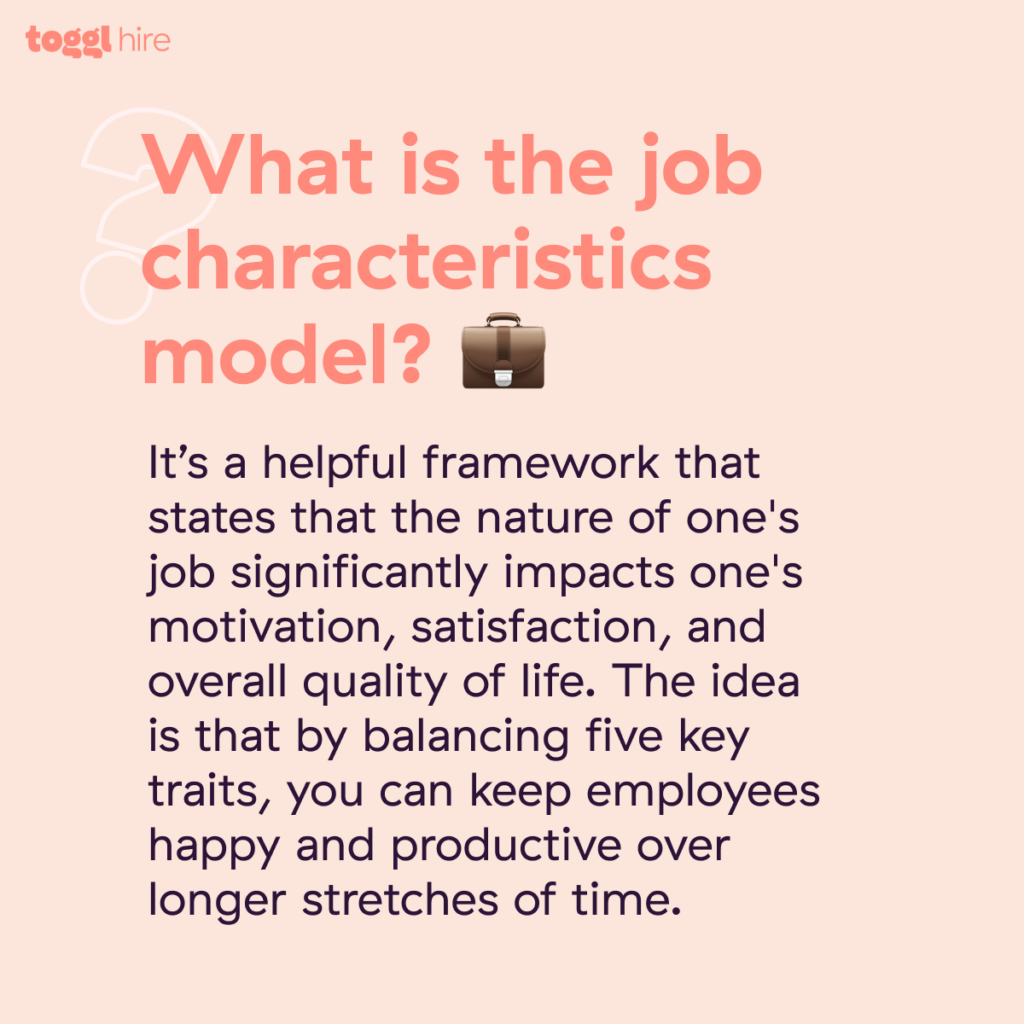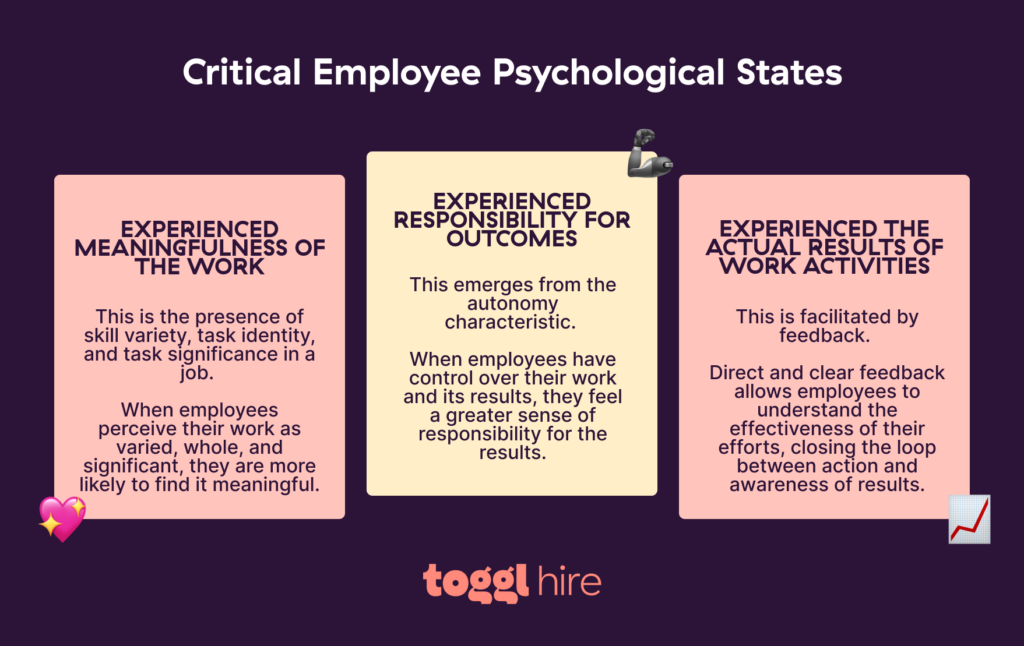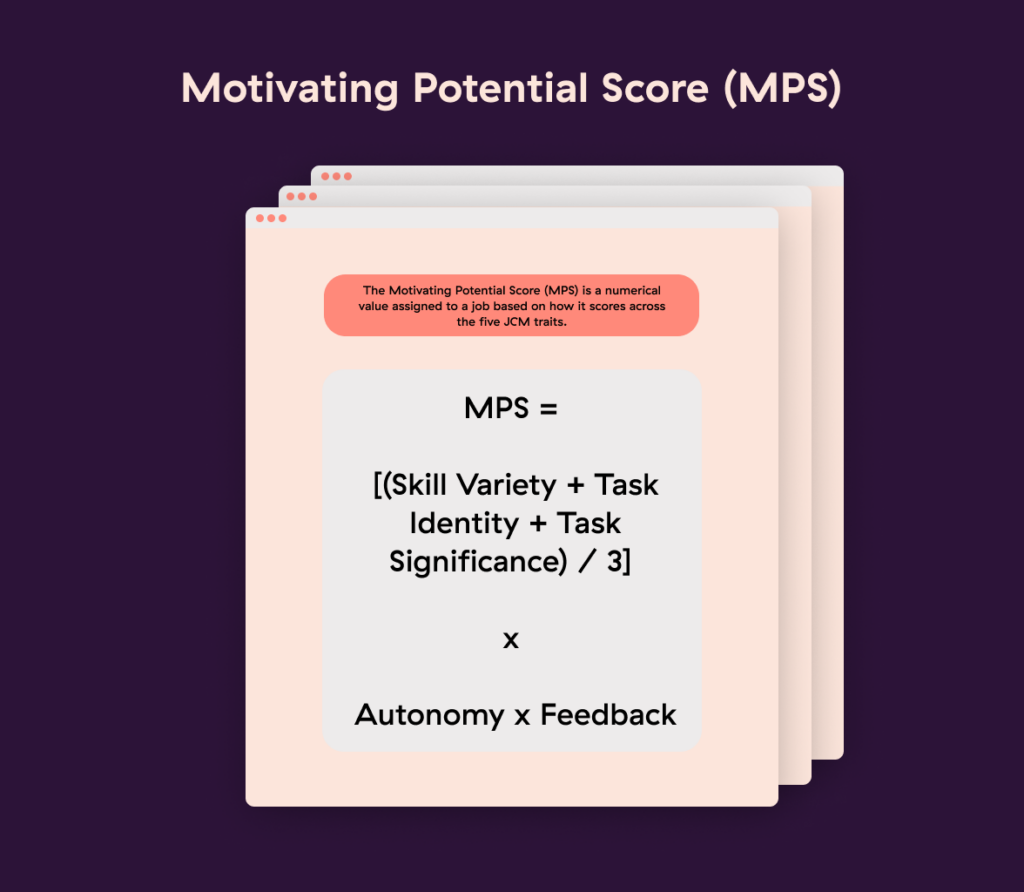Over 50 years old (and perhaps more relevant than ever), the job characteristics model (or JCM for short) promises to motivate employees, boost their satisfaction at work, and improve performance, all in one simple and easy-to-implement framework.
Why is it more relevant than ever? We’re in a crisis of workplace engagement, and millennials, who make up the majority of the current workforce, are leading it. A mere 29% of workers in this demographic report being emotionally or behaviourally invested in their jobs.
When employee engagement tanks, so do retention and morale. How can the JCM help? Let’s dive into it together.
TL;DR — Key Takeaways
The JCM is a classic framework for evaluating a job’s potential to keep employees motivated and fulfilled over long periods of time. It can be a great way to build a specific job description.
It focuses on five traits — skill variety, task significance and identity, autonomy, and feedback — which are said to give rise to certain psychological states that lead to performance outcomes.
Quantitative and qualitative data on how engaged an employee is in a role can be gathered through various methods, such as the job diagnostic survey or the motivating potential score.
Keeping JCM in mind when designing jobs or identifying skills gaps can be incredibly useful for motivating and re-engaging employees.
What is the job characteristics model?
The more experience you have in a job, the more skilled and efficient you become, right?
Back in the 1970s, organizational psychologist J. Richard Hackman and Greg R. Oldham assumed this, too. However, while studying factory workers, they discovered that rather than becoming more productive over time, experienced employees actually lost interest and got bored. As a result, their performance dropped.
Were all employees doomed to cycles of spikes and lulls as their perception of work goes from novelty to monotony?
To answer this question, Hackman and Oldham scrambled to find a way to keep employees engaged with their work over the long term. Finding their answer in the job characteristics model.
The core premise of Hackman and Oldham’s framework states that the nature of one’s job significantly impacts one’s motivation, satisfaction, and overall quality of life.
They argued that by balancing five key traits, you could keep employees happy and productive over longer stretches of time. The five traits of meaningful, satisfying work are skill variety, task identity, task significance, autonomy, and feedback. Each trait is something for employers to add to the mix as a solution to dwindling effort.

Benefits of using Hackman and Oldham’s job characteristics
One of the main reasons HR leaders use the JCM is because it provides management teams with a template for designing rewarding jobs for all industries, skills, and seniority levels. More than a trusted framework, it’s a blueprint for creating more engaging and fulfilling work environments.
1. Creating job design strategies
The JCM provides a systematic approach to job design, encouraging the incorporation of diverse skills, clear responsibilities, and impact into roles. This leads to roles that are not only well-defined but also enriching for employees, fostering a deeper sense of purpose and belonging within the organization.
2. Improved job satisfaction and engagement
In theory, matching job characteristics with employee preferences will boost job satisfaction. When employees are more aligned with their roles on a personal level, this leads to better integration and internal motivation.
Ever since Hackman and Oldman’s original study, there have been multiple subsequent studies showing a strong correlation between job characteristics and satisfaction. Focusing on autonomy and feedback also empowers employees, helping them feel more valued and resulting in higher engagement levels.
3. Better task delegation and autonomy
Autonomy not only liberates employees to put effort toward new ideas — it may be intrinsic to our brain’s motivation system.
In 1985, psychologists Richard Ryan and Edward Deci developed their self-determination theory, asserting that one’s autonomous motivation for personal and psychological growth is the bedrock of personal success and satisfaction. If employees get more autonomy, the theory goes, they’ll feel more satisfied and connected to their work, as any positive results will likely be seen as the result of their own inherent abilities.
The JCM emphasizes a clearer understanding of activities and expected results, which enables management to delegate more effectively. With autonomy as a core characteristic, employees are entrusted with responsibilities, leading to a culture of trust and accountability.
4. Enhanced performance and productivity
Like an algorithm, people get better with feedback. Communicating areas of strength and areas of improvement helps your workforce perform better and get more productive over time, kind of like a fine-tuned algorithm that gets better with every iteration.
The JCM puts a strong focus on feedback, which contributes to higher performance levels. Employees who see the impact of their work also become more motivated to maintain high standards. Planning regular feedback sessions keeps individual goals and growth aligned with employer goals, enhancing overall productivity.
5. Reduced turnover and absenteeism
The JCM model also predicts reduced turnover and absenteeism. When employees find their work meaningful and are satisfied with their roles, they are less likely to seek employment elsewhere. They’re also more likely to give their job their all and show up as their best selves every day. This stability is crucial for maintaining a skilled and experienced workforce.

5 core job characteristics
The five job characteristics themselves are listed in no particular order — all carrying equal importance. They lean on each other to create the framework, complete with psychological states and overall results, which can be alluded to in job descriptions.
1. Skill variety
The degree to which a job requires a variety of skills to complete the necessary activities associated with the position. For example, a business development manager may require less skill variety — they create outreach lists and speak with prospects all day — than, say, a revenue officer. This role will require a much higher variety of skills, juggling growth projections, reviewing sales projects, approving budgets, and overseeing the activity of different departments and teams.
2. Task identity
Do the tasks have a clear beginning and end? Is there a point where you can tell you’ve moved from one task to another, or do they all bleed together? Roles with multiple moving parts, a clear start and end, and a visible outcome are considered to have high levels of task identity. Some roles that come to mind are project manager, architect, and marketing manager.
3. Task significance
This trait has to do with the degree to which a job has a meaningful impact on the lives or work of others. The broader the reach of your actions and decisions, the higher the significance of the task. For example, a restaurant owner’s task significance is much higher than that of a line cook because their decisions affect everything from the inventory, menu, and pricing to the clientele, decor, and marketing of the establishment.
4. Autonomy
To what extent does the employee have the freedom to decide how and when to do their work? Are they being micromanaged or empowered to take their ideas seriously? Injecting autonomy into your organization’s values provides the company with a culture of ownership and responsibility. The more independence and discretion in decision-making, the more productive and successful employees are in their roles.
5. Feedback
Feedback is a measure of validation, effectiveness, and impact. This can either be internal, like a hotel maid seeing the impact of her turndown service after completing it, or external, like an IT security team who can only understand their recent build is rock-solid after penetration testing. Either way, employees need direct and clear information about their effectiveness in their positions to feel satisfied.

A real example of a job characteristics model
Now, let’s put these (admittedly) abstract concepts into practice. Think of a backend developer.
Skill variety: High
Backend developers work with many different programming languages, databases, and frameworks. They also use a range of tools for designing, developing, and maintaining the backend of web applications. Sometimes, they may need to collaborate with other stakeholders like frontend developers or designers.
Task identity: Varies based on project
For backend developers, this one can vary depending on the project and team structure. In some cases, backend developers may work on specific components of a larger system, which means they get to see the impact of their work on the overall outcome. If they change management, they might be working on smaller, isolated tasks without a clear view of how their work contributes to the final product.
Task significance: High
Backend developers play a key role in making sure technologies and web applications are fully functional, performing well, and staying secure from cyber threats. Their engineering work may not always be visible to end-users, but it directly impacts their experience.

Autonomy: High
Backend developers usually enjoy high autonomy in their roles. They can choose what they deem to be the most suitable technologies, tools, and approaches for solving problems. That autonomy bleeds into their work schedules, especially in agile or flexible work environments, where they can usually arrange their week as they wish, within reason.
Feedback: Medium
Backend developers get direct (but sometimes unclear) feedback from the very code they work with. Something might malfunction, indicating a problem. But the source of the problem is not always so obvious. They may also receive feedback from code reviews and reports from users. However, the quality and frequency of feedback can depend on company culture and the nature of the product they’re building.
How to measure job characteristics
Understanding how the model works is half the game. Now comes learning how to measure it. There are a few different ways to do this, each with its own benefits and limitations. The best measurement technique will depend on your organizational needs, team size, and type of roles.
Objective vs. perceptual measurement techniques
Let’s begin with the basics. Objective and perceptual measurements are the two primary approaches to measuring job characteristics.
Objective measurements involve quantifiable data, such as the number of different tasks performed or the frequency of feedback provided.
Perceptual measurements, on the other hand, rely on employees’ perceptions and evaluations of their job characteristics.
Both are valuable as they show two sides of the same coin. Objective measurements provide quantitative data, while perceptual measures paint a qualitative picture of an employee’s inner world and how they’re currently experiencing their work life.
Job diagnostic survey
Hackman and Oldham developed a job diagnostic survey to complement their JCM. It was purpose-built to measure the core dimensions of the JCM.
Following the same idea as the perceptual measurement technique, this survey assesses employees’ perceptions of their jobs. It depends on them self-reporting their experience, which makes it valuable to an organization by helping identify ways to improve employees’ motivation and satisfaction.
Job characteristics inventory
The job characteristics inventory (JCI) is a framework developed soon after the JCM that also aims to measure employee’s perceptions of their jobs. The JCI comprises 30 items grouped into six subscales corresponding to the JCM’s core characteristics. This inventory allows for a detailed analysis of a job’s variety, autonomy, feedback, interaction with others, and more.
This tool can help organizations identify specific areas for job design improvement by providing granularity on which specific characteristics are underrepresented in an employee’s experience.
Critical psychological states
Job characteristics really are just abstract proxies for the real thing we’re after — employees’ psychological states. The JCM outlines five key job characteristics and says they feed into creating three critical psychological states: experienced meaningfulness of the work, experienced responsibility for outcomes, and knowledge of the actual results of the work activities.
Experienced Meaningfulness of the Work is the presence of skill variety, task identity, and task significance in a job. When employees perceive their work as varied, whole, and significant, they are more likely to find it meaningful.
Experienced Responsibility for Outcomes emerges from the autonomy characteristic. When employees have control over their work and its results, they feel a greater sense of responsibility for the results.
Knowledge of the Actual Results of the Work Activities is facilitated by feedback. Direct and clear feedback allows employees to understand the effectiveness of their efforts, closing the loop between action and awareness of results.

Mapping characteristics to employee’s psychological and emotional states is invaluable for organizations. It allows you to “translate” what an employee reports into actionable steps for your human resources team.
It’s unlikely an employee will tell you, “I need higher skill variety,” but they might well say they feel bored and think their work lacks meaning. A clear signal that an increase in skill variety might be in order.
Motivating Potential Score (MPS)
The Motivating Potential Score (MPS) is a numerical value assigned to a job based on how it scores across the five JCM traits.
It can be calculated like so:
MPS = [(Skill Variety + Task Identity + Task Significance) / 3] x Autonomy x Feedback
The higher the MPs, the more likely a job is to foster intrinsic motivation among employees, leading to higher job success and satisfaction.
It is interesting to note that while all elements of the JCM play a role in shaping employee motivation, Autonomy and Feedback are assigned a multiplicative effect on the overall motivating potential of a role.

How to apply the job characteristics model
So we know what the JCM is, and we know how to measure it — now it’s time to apply it. We’ve gathered some top tips for successful implementation and future improvement below.
Understand your team’s current job design
The first port of call is to analyze your current team’s job roles and responsibilities to see how much they align with the five core job characteristics. The ultimate goal here is to ensure you know the current state of job design within your organization. This will provide a solid foundation for applying the model effectively in later steps.
Identify opportunities for improvement
Based on this initial analysis, pinpoint areas where job roles can better align with the JCM. For example:
Increase skill variety by introducing different tasks.
Enhance task significance by clarifying the impact of employees’ work on others.
Boost autonomy by empowering employees to delegate decision-making.
Involve employees in the redesign process
Be transparent about what you’re doing and engage employees from the jump. Their insights and suggestions could prove invaluable and offer perspective on something you might’ve missed.
Involvement in job design not only empowers workers but also ensures that changes will be positively received and more closely aligned with their needs and preferences.
Implement incremental changes
Redesign jobs the same way you would eat an elephant — one bite at a time.
Focus on no more than a handful of aspects at a time. This gives you the space to monitor the impact of these new changes on employee motivation, satisfaction, and performance – and to make adjustments as necessary.
Incremental changes also help in managing the transition more smoothly, minimizing disruption to daily operations and helping you avoid overwhelm in what can be a long and intense process!
Enhance job design with Toggl Hire
Effectively implementing the JCM model requires having the right tools.
Toggl Hire can enable organizations to accurately assess candidates’ skills and fit for specific job characteristics from the outset. By incorporating skill tests tailored to the core job dimensions — skill variety, task identity, task significance, autonomy, and feedback — Toggl Hire ensures that new hires are well-suited to positions designed for maximum motivation and satisfaction.
Furthermore, Toggl Hire’s data-driven insights can aid in the ongoing evaluation and redesign of roles within your organization. By understanding the skill sets and preferences of your team, you can make informed decisions on how to enhance job characteristics, leading to improved employee engagement and success.
By leveraging the power of Toggl Hire alongside the JCM, organizations can create a dynamic and satisfying work environment that not only attracts but also retains top talent. Create a free account to see for yourself!

Julia is a freelance writer and fierce remote work advocate. While traveling full-time, she writes about the intersection of technology and productivity, the future of work, and more. Outside work, you can find her hiking, dancing, or reading in a coffee shop.





